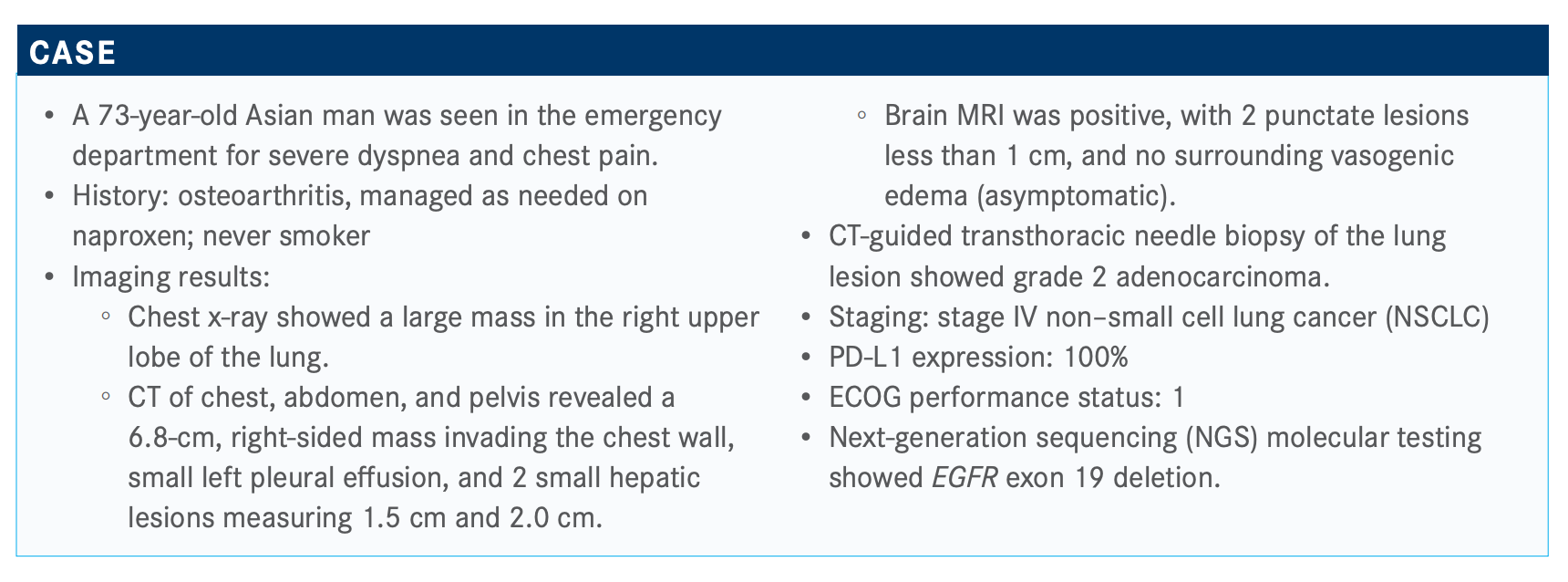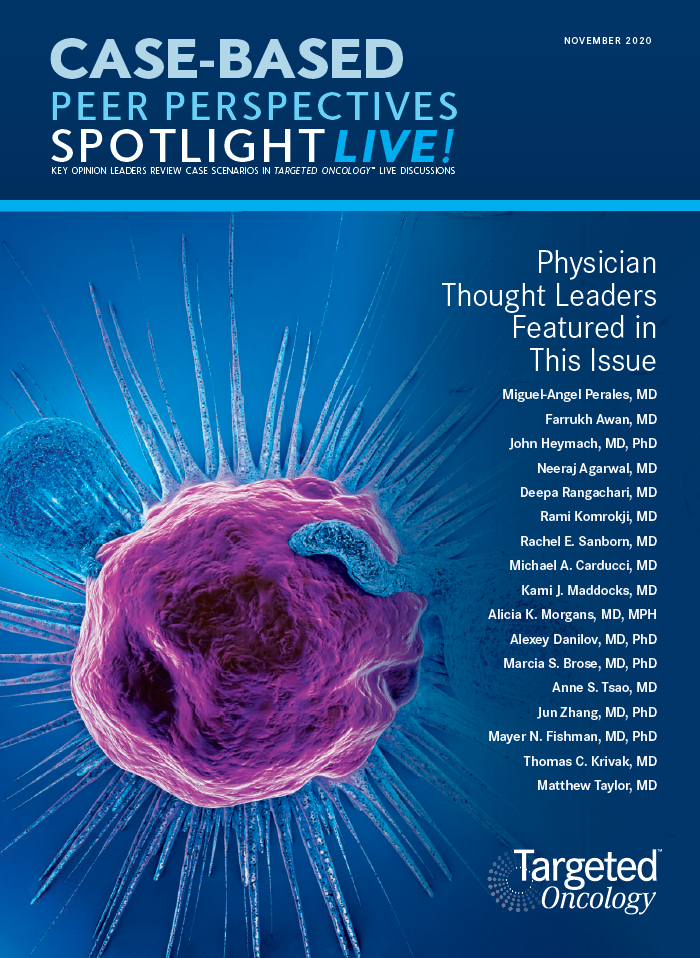Frontline Regimens Explored for EGFR-Mutated NSCLC
During a Targeted Oncology Case Based Peer Perspective event, John Heymach, MD, PhD Chair, Department of Thoracic/Head and Neck Medical Oncology The University of Texas MD Anderson Cancer Center, discusses the case of a 73-year-old Asian patients with EGFR-mutant non–small cell lung cancer.
John Heymach, MD, PhD

During a Targeted Oncology Case Based Peer Perspective event, John Heymach, MD, PhD Chair, Department of Thoracic/Head and Neck Medical Oncology The University of Texas MD Anderson Cancer Center, discusses the case of a 73-year-old Asian patients with EGFR-mutant non–small cell lung cancer (NSCLC).

Targeted Oncology™: How would you reassure a patient who is eager to start treatment?
HEYMACH: Patients are anxious to get their treatment started. I tell them that their tumor has probably been growing for 2 to 3 years, on average; [the only thing] that’s changed in the last 1 or 2 weeks is their knowledge of it. But the tumor has been [growing] for a couple of years, so an extra couple of weeks doesn’t make a difference.
Interestingly, if you start immunotherapy and then go to osimertinib [Tagrisso], the risk of pneumonitis may be dramatically higher. I try to hold off on immunotherapy before starting a TKI [tyrosine kinase inhibitor]. If I absolutely need to start treatment, I start chemotherapy [and] leave the immunotherapy out until we get the results and then switch to immunotherapy or a TKI.
There is a rationale for all of these but if I have to start something because a patient needs something quick, I’ll often start chemotherapy without the immunotherapy and then add it in after the [molecular] profiling [results] come back.
How have the recommendations for frontline testing in nonsquamous NSCLC changed?
The NCCN [National Comprehensive Cancer Network] guidelines are changing so quickly.1 In the last couple of months, we had approval for RET [rearrangement-positive NSCLC] with selpercatinib [Retevmo]. For MET exon 14 [skipping mutations], there is capmatinib [Tabrecta]. Now we have BRAF/MEK inhibitor drugs with dabrafenib [Tafinlar] and trametinib [Mekinist]. We have ROS1 drugs like crizotinib [Xalkori] and entrectinib [Rozlytrek], a host of ALK inhibitors, and multiple EGFR inhibitors.
There are now approved therapies for 7 different driver oncogenes. Based on this, the NCCN recommendations moved to NGS.
[Because] we have [FDA-approved therapies] for all these oncogenes plus NTRK, I think NGS is most appropriate. The other benefit of NGS is [that] there are alterations [for which] we have promising drugs coming down the pike. We have HER2-targeting drugs that look promising now. We have EGFR exon 20–targeting drugs. We have NRG1 fusion drugs. All these [mutations] will emerge from NGS, hence the NCCN recommendation [of the] NGS panel. For PD-L1, the Dako 22C3 assay is recommended. I don’t think we want to limit ourselves to EGFR and ALK mutations anymore. We want to do the full panel.
What’s not listed are KRAS mutations. It’s debatable whether to run [tests for] KRAS mutations. We don’t have approved drugs for it, but one advantage of [the tumor] being KRAS positive is it’s unlikely [there is] another driver oncogene. I would usually add KRAS mutations to the mix. That makes a total of 8 different oncogenes that we would routinely profile.

What are the patients' options for frontline treatment? In the past 2 months, we had the approval of the RELAY [NCT02411448] regimen, which is ramucirumab [Cyramza], the VEGFR-2 inhibitor, with erlotinib [Tarceva].2
Osimertinib has a better response rate than first- and second-generation [EGFR TKIs]. It has a longer median PFS [progression-free survival] versus other drugs at about 19 months. Also, osimertinib has proven activity in brain metastases.
Do you go with osimertinib first or keep osimertinib for later?
Per the NCCN recommendations, what they have right now is osimertinib as preferred over other options, [such as] fi rstgeneration erlotinib.1 They’ve [moved] gefi tinib [Iressa] as “other recommended.” Gefi tinib lost in head-to-head comparisons with osimertinib and with afatinib [Gilotrif], so some people will put [it] lower than dacomitinib [Vizimpro]. Now with the [RELAY] results,3 we have erlotinib and ramucirumab.
There are [data from a] randomized phase 2 [trial] supporting erlotinib and bevacizumab [Avastin], [but] that isn’t yet an FDA-approved regimen.4
In your practice, do you face any barriers to oral medications for patients with EGFR-positive NSCLC?
The price of these drugs can be a bit jarring, with most TKIs being in the $12,000 to $15,000 a month range now. We have a lot of patients that come from abroad who go down to the pharmacy to pick up their prescription and get a bit of a shock. We have occasionally faced some issues with coverage of particular drugs but that seems to be decreasing recently.
Most or many insurers would use specialty pharmacies for these medications and their cost. For some of our patients, getting them shipped can be a little tricky and where they get sent, but it seems like most people are able to get their patients’ drugs OK.
What data support the use of osimertinib as the preferred first-line treatment for advanced EGFR-mutant NSCLC?
The FLAURA trial [NCT02296125] was of first-line osimertinib versus standard of care for EGFR-mutant NSCLC.5 This was a comparison of osimertinib versus erlotinib or gefitinib at the standard doses. Patients were treated until progression. The primary end point was PFS; this study was in patients with an exon 19 or L858R mutation. And notably, this trial permitted stable CNS [central nervous system] metastases, which is not the case with [other] large studies. Osimertinib has CNS penetration.
The median PFS was 18.9 months [with osimertinib] versus 10 months [with standard of care], with a hazard ratio of 0.46 [95% CI, 0.37-0.57; P < .0001], so a striking difference.5
The [initial] hazard ratio [for overall survival (OS)] was not as big of a difference, 0.63 [95% CI, 0.45-0.88; P = .0068], but there was a clear difference in OS. It’s exciting. [If] you looked at 30-month [data, patients are] nowhere near the median OS. With osimertinib, the estimated median OS is going out to about 39 months now.6 That’s a giant step forward for these patients. When we first identified EGFR mutations in 2003, the median survival for this group was 7 to 10 months.
About 47% of patients crossed over from the standard-of-care treatment and ended up getting osimertinib.6 The true differences, if you didn’t have osimertinib, would be even larger [without crossover]. It’s interesting to look at OS by this group. It is an important point [that] virtually everyone had a significant benefit with osimertinib compared with other TKIs.
It seems like [OS with osimertinib] was less in Asian patients. If you look at the L858R mutation, [there was] less benefit than with the exon 19 deletion. There are earlier studies also showing [that] exon 19 deletions had better outcomes [with] osimertinib.
Patients who had CNS metastases had about as much benefit [as with standard therapy].5 There were broad benefits with the potential exception of the L858R mutation, where there was not a benefit in OS.
How do the results of the AURA3 trial (NCT02151981) apply to osimertinib use in this patient population?
Osimertinib was first approved on the basis of the AURA3 study. Patients that get a first- or second-generation EGFR TKI develop a T790M mutation in about 50% to 60% of cases.
[AURA3] was a comparison of osimertinib versus chemotherapy for EGFR-mutant disease [in patients] who already had a TKI.7 [There was] a striking difference between the 2 [treatment groups]—the hazard ratio was 0.30 [95% CI, 0.23-0.41]. The median PFS was 10.1 months [with osimertinib versus 4.4 months with platinum/pemetrexed]. In the frontline setting, the median PFS was 18.9 months.5 [Patients in] this study already [received] a first-generation TKI [and] that would’ve taken them out for an average of a year.
The [results of this trial] led to the FDA approval of osimertinib for EGFR T790M–positive, EGFR TKI–refractory NSCLC.
Based on the RELAY data and the FDA approval of ramucirumab/erlotinib, how do you consider this regimen in your frontline decision-making?
Studies of VEGF [vascular endothelial growth factor] inhibition with erlotinib and bevacizumab or ramucirumab [RELAY regimen] showed a significant improvement in PFS [compared with erlotinib alone].7,8 The OS data are not yet mature. In some cases, the OS was not prolonged. There was consistent PFS improvement with the addition [of] a VEGF inhibitor. It looked like the best biomarker we had for VEGF inhibitors was EGFR mutation, ironically.
Based on the [results of the] RELAY study, the FDA approved ramucirumab plus erlotinib for the first-line [treatment of] metastatic NSCLC with exon 19 and L858R mutant tumors. The RELAY study included 449 patients, with 1:1 randomization.3
This wasn’t the approved dose, but the dose was [ramucirumab] every 2 weeks with erlotinib at 150 mg a day versus placebo.3 The primary end point of the study was PFS. [There was] a significant and substantial difference in PFS—19.4 months versus 12.4 months with erlotinib alone. In FLAURA, it was 18.9 months with osimertinib alone.
The hazard ratio for PFS was 0.59 [95% CI, 0.46-0.76; P <.0001], which was significant.3 The OS data are immature at this point. Across subgroups, the benefit appears to be consistent. If you look at exon 19 deletion versus L858R, L858R had slightly greater benefit, but the 2 looked comparable.
We don’t see the same difference with exon 19 deletion and L858R as seen in the osimertinib studies. One thing that’s worth pointing out is that these studies did not include patients with CNS metastases [like] the osimertinib study did.
Median PFS by exon 19 deletion and L858R were similar.6 Erlotinib was a bit worse with L858R than with exon 19 deletion. In terms of treatment-related adverse events, the big one was hypertension. It significantly increased. About 24% [of patients given ramucirumab] had grade 3 [hypertension]. This was typically managed with antihypertensives. Five percent of patients given placebo [had hypertension]
Hypertension didn’t lead [to] treatment discontinuation. There were some bleeding events, which were usually nosebleeds or some hemoptysis, but none of those were grade 3 [in severity].3 There was no increase in [grade 3] pulmonary hemorrhage or gastrointestinal hemorrhage compared with placebo.
Using plasma to detect progression, patients ended up having the same rate of T790M [development] whether they got ramucirumab and erlotinib or erlotinib alone.6 They were able to go on and get subsequent osimertinib at the same rate. Some patients who don’t have [the mutation detected] in plasma get tissue biopsies and then subsequently have EGFR T790M–positive tumors. The true rates of T790M will certainly be higher when you add in the tissue T790M-positive rates.

Are you concerned about resistance to first-line osimertinib for these patients? How would you proceed if there is progession on osimertinib?
[In] an analysis from Memorial Sloan Kettering Cancer Center, looking at resistance to first-line osimertinib isn’t as simple as we end up seeing with first- and second-generation TKIs, where more than half the cases [developed] T790M and we had a drug for it.
A substantial portion [of patients] have transformation [to small cell lung cancer] or squamous transformation [with osimertinib].9 Sometimes you get off-target resistance mutations like RET fusions, BRAF mutations, KRAS, or the most common one, MET amplification.
On the EGFR side, there [are] a couple of EGFR mutations.9 One’s C797S. Another is L792H and 7G724S. There are no drugs approved for any of these resistance mechanisms. So unlike first line, where you have drugs approved for T790M, we don’t have any targeted drugs approved. The next line would be chemotherapy and/or immunotherapy.
References:
1. NCCN. Clinical Practice Guidelines in Oncology. Non-small cell lung cancer, version 8.2020. Accessed October 23, 2020. https://bit.ly/2HC0s7G
2. FDA approves ramucirumab plus erlotinib for first-line metastatic NSCLC. FDA. May 29, 2020. Updated June 1, 2020. Accessed October 29, 2020. https://bit.ly/37XFVFn
3. Nakagawa K, Garon EB, Seto T; RELAY Study Investigators. Ramucirumab plus erlotinib in patients with untreated, EGFR-mutated, advanced non-small-cell lung cancer (RELAY): a randomised, double-blind, placebo-controlled, phase 3 trial. Lancet Oncol. 2019;20(12):1655-1669. doi: 10.1016/S1470-2045(19)30634-5
4. Saito H, Fukuhara T, Furuya N, et al. Erlotinib plus bevacizumab versus erlotinib alone in patients with EGFR-positive advanced non-squamous nonsmall-cell lung cancer (NEJ026): interim analysis of an open-label, randomised, multicentre, phase 3 trial. Lancet Oncol. 2019;20(5):625-635. doi:10.1016/ S1470-2045(19)30035-X
5. Soria JC, Ohe Y, Vansteenkiste J, et al; FLAURA Investigators. Osimertinib in untreated EGFR-mutated advanced non–small-cell lung cancer. N Engl J Med. 2018;378(2): 113-125. doi:10.1056/NEJMoa1713137
6. Ramalingam SS, Gray JE, Ohe Y, et al. Osimertinib vs comparator EGFR-TKI as firstline treatment for EGFRm advanced NSCLC (FLAURA): final overall survival analysis. Ann Oncol. 2019;30(suppl 5):V914-V915. doi:10.1093/annonc/mdz394
7. Landre T, Des Guetz G, Chouahnia K, et al. Angiogenesis inhibitor plus erlotinib versus erlotinib alone as first-line for advanced non-small cell lung-cancer harboring EGFR mutation. J Clin Oncol. 2020;38(suppl 15):9569. doi:10.1200/ JCO.2020.38.15_suppl.9569
8. Maemondo M, Fukuhara T, Saito H, et al; North East Japan Study Group. NEJ026: final overall survival analysis of bevacizumab plus erlotinib treatment for NSCLC patients harboring activating EGFR-mutations. J Clin Oncol. 2020;38(suppl 15):9506. doi: 10.1200/JCO.2020.38.15_suppl.9506
9. Schoenfeld AJ, Chan JM, Kubota D, et al. Tumor analyses reveal squamous transformation and off-target alterations as early resistance mechanisms to first-line osimertinib in EGFR-mutant lung cancer. Clin Cancer Res. 2020;26(11):2654-2663. doi:10.1158/1078-0432.CCR-19-3563
